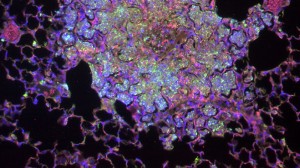Francisella tularensis is a highly infectious microorganism with fewer than 10 inhaled bacteria causing the fatal disease tularemia. This bacterium has been weaponized and could be used for bioterrorism, prompting the Center for Disease Control and Prevention to classify F. tularensis as a Category A biodefense agent. In addition to the threat of an intentional release, F. tularensis causes a variety of naturally occurring human infections that can be acquired by inhalation, arthropod bites, oropharyngeal exposure, or by contact. My long term goals involve understanding the pathogenesis, persistence, and transmission, of F. tularensis. Ultimately, I am interested in identifying novel therapeutics to combat this pathogen and other bacterial pathogens.
The virulence of F. tularensis has principally been associated with this organism’s ability to replicate within phagocytic cells of the innate immune system, such as macrophages. In addition to macrophages, F. tularensis can invade and replicate in a range of non-phagocytic host cells such as alveolar epithelial cells, kidney epithelial cells, hepatocytes, and fibroblasts. F. tularensis also employs mechanisms to suppress the host innate immune response, resist complement, and inhibit macrophage and neutrophil effector functions. The ability of F. tularensis to detect and respond to environmental signals contributes to this organism’s success as a pathogen. My work has shown that mammalian temperature modulates virulence gene expression. Differential responses to temperature by F. tularensis, as determined by microarray analysis, provided a focused list of relevant candidate virulence determinants to investigate further. These virulence factors will be primary therapeutic targets.
Uptake of F. tularensis into both macrophages and non-phagocytes is mediated by the host cell’s endocytic machinery. Recently, I made the observation that Francisella also invades erythrocytes during infection – cells incapable of endocytosis. A focus of my research program involves examination of the molecular mechanisms facilitating erythrocyte invasion by F. tularensis and the biological role of this phenomenon. Both erythrocyte and bacterial factors will be investigated for their contribution toward invasion. To elucidate the biological role of erythrocyte invasion, I intend to investigate whether erythrocyte invasion contributes to the pathogenesis of F. tularensis. Because erythrocytes are long-lived cells, I will also explore a role in disease persistence for invasion of red blood cells. Other pathogenic bacteria that invade erythrocytes do so to enhance transmission by arthropod vectors, such as ticks. Therefore, I will examine a role in enhancing arthropod transmission. Furthermore, I have established collaborations that will allow me to examine clinical specimens from tularemia patients to assess the level of erythrocyte invasion during human infection. The information generated in these studies will enhance our understanding of this pathogen’s biology during different stages of infection. Also, by understanding how the erythrocyte is manipulated to allow F. tularensis access to its intracellular space, we will gain insight into the cell biology of red blood cells.
My research agenda also involves investigating the pathogenesis of the opportunistic pathogen, Pseudomonas aeruginosa. In addition, I am developing and characterizing a novel live vaccine platform that can be engineered to elicit protection against a variety of bacterial pathogens including P. aeruginosa.
Joseph Horzempa’s Faculty Page
Publications
Russo, B.C., J. Horzempa, D.M. O’Dee, D.M. Schmitt, M.J. Brown, P.E. Carlson Jr., R.J. Xavier, and G.J. Nau. 2011. A Francisella tularensis locus required for spermine responsiveness is necessary for virulence. Infect. Immun. In press.
Horzempa, J., D.M. O’Dee, D.B. Stolz, J.M. Franks, D. Clay, and G.J. Nau. 2011. Invasion of erythrocytes by Francisella tularensis. J. Infect. Dis. 204: 51-59.
Editorial commentary by J. Wayne Conlan. 2011. Francisella tularensis: A Red-blooded Pathogen. J. Infect. Dis. 204: 6-8
Kalivoda, E.J., J. Horzempa, N.A. Stella, A. Sadaf, R.P. Kowalski, G.J. Nau, and R.M.Q. Shanks. 2011. New vector tools with a hygromycin resistance marker for use with opportunistic pathogens. Mol. Biotechnol. 48:7-14
Qutyan, M., M. Henkel, J. Horzempa, M. Quinn, and P. Castric. 2010. Glycosylation of pilin and nonpilin protein constructs by Pseudomonas aeruginosa 1244. J. Bacteriol. 192:5972-81.
Horzempa, J., D.M. O’Dee, R.M.Q. Shanks, and G.J. Nau. 2010. Francisella tularensis ΔpyrF mutants show that replication in non-macrophages is sufficient for pathogenesis in vivo. Infect. Immun. 78:2607-19.
Horzempa, J., R.M.Q. Shanks, M.J. Brown, B.C. Russo, D.M. O’Dee, and G.J. Nau. 2010. Utilization of an unstable plasmid and the I-SceI endonuclease to generate routine markerless deletion mutants in Francisella tularensis. J. Microbiol. Methods. 80:106-8
Carlson Jr., P.E.*, J. Horzempa*, D. M. O’Dee*, C.M. Robinson, P. Neophytou, A. Labrinidis, and G.J. Nau. 2009. Global transcriptional response to spermine, a component of the intra-macrophage environment, reveals regulation of Francisella gene expression through insertion sequence elements. J. Bacteriol. 191:6855-64. *These authors contributed equally to this work.
Horzempa, J., P.E. Carlson Jr., D.M. O’Dee, R.M.Q. Shanks, and G.J. Nau. 2008. Global transcriptional response to mammalian temperature provides new insight into Francisella tularensis pathogenesis. BMC Microbiol. 8:172.
Horzempa, J., T.K. Held, A.S. Cross, D. Furst, M. Qutyan, A.N. Neely, and P. Castric. 2008. Immunization with Pseudomonas aeruginosa 1244 pilin provides O-antigen-specific protection. Clin. Vaccine Immunol. 15:590-597.
Horzempa, J., D.M. Tarwacki, P.E. Carlson, Jr., C.M. Robinson, and G.J. Nau. 2008. Characterization and application of a glucose-repressible promoter in Francisella tularensis. Appl. Environ. Microbiol. 74:2161-2170.
Horzempa, J., C. Dean, J. Goldberg, and P. Castric. 2006. Pseudomonas aeruginosa 1244 pilin glycosylation: glycan substrate recognition. J. Bacteriol. 188:4244-52.
Horzempa, J., J. E. Comer J.E., S. A. Davis, and P.A. Castric. 2006. Glycosylation substrate specificity of Pseudomonas aeruginosa 1244 pilin. J. Biol. Chem. 281:1128-1136.
Smedley, J.G., III*, E. Jewell*, J. Roguskie*, J. Horzempa*, A. Seyboldt, D. B. Stolz, and P. Castric. 2005. Influence of pilin glycosylation on Pseudomonas aeruginosa 1244 pilus function. Infect. Immun. 73:7922-7931. *These authors contributed equally to this work.
